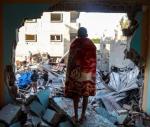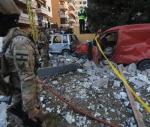You are here
Gaza's monuments become ruins
Nov 05,2023 - Last updated at Nov 05,2023
Armed conflicts threaten not only civilian populations, but also cultural property. Although cultural heritage is protected by several legislation, for example the Hague Convention for the Protection of Cultural Property in the Event of Armed Conflict of 1954 AD, this did not prevent the Zionist entity from targeting Palestinian cultural heritage, as those who do not respect the lives of children and innocent civilians will not respect the integrity of cultural heritage.
Israeli forces launched its aggression against the Gaza Strip several times. Its new series began in late 2008, late 2012, 2014, 2019, 2021, 2022, and most recently, 2023. This led to widespread damage in all aspects of the Palestinian life, including economic, social and urban life. Its impact on the urban heritage represented by archaeological sites and architecture has a broader impact, and every time the Palestinians were subject to death and their heritage was subject to theft and destruction. Even the intangible cultural heritage, such as customs, traditions, food and fashion, was not spared from Israeli tampering, and they attributed much of it to themselves.
Gaza is full of many places of cultural significances, such as museums and important archaeological and cultural sites. All of these places and sites have suffered and are suffering from the effects of the Israeli aggression, especially with the aggressor’s use of white phosphorus bombs, which are banned internationally, as well as seismic bombs.
Gaza museums
Gaza includes 12 museums containing approximately 12,000 artifacts, all of which were built through personal efforts from the desire of the people of Gaza to preserve their heritage. These museums were subjected to varying degrees of damage as a result of the Israeli bombing, in addition to leaving some of them unguarded or followed up, either displacing those in charge of them or killing some of them, which led to the theft of many of their exhibits, which in many cases appear again in Israeli museums.
The Israeli bombing caused great damage to the Khan Yunis Museum, destroyed many artifacts, and severely damaged the museum building. Among the most prominent museums in Gaza that were subjected to damage ranging from cracks in their walls and cracks or destruction or breakage of some collectibles is the Akkad Museum, which was established 44 years ago and includes 2,800 artifacts from prehistoric to modern times, as well as the Pasha Palace Museum, was built in the Mamluk era and was transformed to a museum in 2010, it was subjected to damage that required urgent intervention.
Archaeological mosques
Al-Sayyid Hashem Mosque, which is the mosque that was built over the tomb of the Prophet’s grandfather; Hashem Bin Abd Manaf. It was destroyed in World War I in 1917, and was rebuilt again, but the continuous bombing around it led to some of its walls cracking, and the same was true for the Sheikh Zakaria Mosque in the Daraj, which was established in the fifth century AH/11th century AD.
The Al Shamaa Mosque in the Al Najjarin neighbourhood, the Sheikh Abdullah Mosque, which is an old mosque in the Al Tuffah neighbourhood, where Sheikh Abdullah Al Aybak is buried, who was one of the Mamluks of the Mamluk Sultan Izz Al-Din Aybak, and the Ibn Othman Mosque, which was built in the eighth century AH, were not spared from destruction due to the of the Israelis aggression.
The Great Mosque of Gaza, also known as the Great Omari Mosque, is the largest and oldest mosque in Gaza Strip. The site was originally the site of an ancient Palestinian temple that was later used by the Byzantines to erect a church in the 5th century AD. After the Islamic conquest in the seventh century AD, it was converted into a mosque. The mosque was restored and rebuilt several times by the Mamluks and Ottomans, respectively, in the thirteenth and sixteenth centuries AD. This mosque is located in northern Gaza, where the brutal occupation forces are intensifying their aggression, so it is currently not possible to accurately know the degree of destruction that occurred to it.
Ibn Othman Mosque is a historic mosque located in the Shuja’iya neighbourhood in Gaza City, and it is considered one of the most beautiful examples of Mamluk architecture in Palestine. The mosque was built during the Mamluk era in the fifteenth century AD by Sheikh Ahmed bin Othman.
The Shrine of Ibrahim Al-Khalil
It is located in the large village of Abasan, and directly to the south of the shrine, there is a floor made of beautiful colored mosaics with drawings that varied between birds, plant leaves, decorative scrolls, writings, and the “Mafruka” swastika decoration. This floor dates back to the year 606 AD.
In addition, there are many ancient mosques that carry many cultural values, such as the Al-Maghribi Mosque and the Al Makma Al Bardabek Mosque.
Among the archaeological facilities that were damaged by the Israeli bombing of Gaza is the Sabil of Sultan Abdul Hamid, or what is known as the “Sabil of Al-Rifa’iyya.” It is one of the oldest monuments known in the Ottoman era, and it is the only remaining Sabil. The Sabil was built in 1570 AD, and is located in Al Wahda Street in the Daraj neighbourhood near the Pasha Palace Museum, and to this day it still maintains the old form of its building.
The Port of Anthedon or the archaeological site of Balakhia is an archaeological site located northwest of the ancient city of Gaza in Palestine. The site is a port dating back to the Hellenistic period, which continued to exist until the Byzantine era.
Qaisaria Market
It is located in the Al Daraj neighborhood and is adjacent to the southern wall of the Grand Al Omari Mosque. The building of the market dates back to the Mamluk era and consists of a street covered with a pointed vault, and on both sides of this street are small shops covered with intersecting vaults. It is called the Al Qaysariyya Market or the Gold Market in reference to the gold trade in it.
Barquq Castle
The construction of the castle was completed in the year 789 AH — 1387 AD. It was built in the form of a complete government complex. It is a sturdy fort with high walls. It contains a mosque and a well. An guesthouse was built to receive travelers, and a stable for horses. On the walls of the castle there are four watchtowers and protection towers. A garrison of knights resided in the castle, and until recently, until 1956 AD, most of the castle’s internal buildings were present, but they gradually disappeared, and one of the gates, the minaret, and parts of the castle wall remained a witness to the greatness of this important historical monument.
In conclusion, it can be said that as a result of the continued Zionist aggression against Gaza, it is difficult, or even impossible, to estimate the extent of the destruction that occurred to the Palestinian heritage, especially its architectural heritage.
Mustafa Al Naddaf is dean of the Faculty of Archaeology and Anthropology at the Yarmouk University













Add new comment